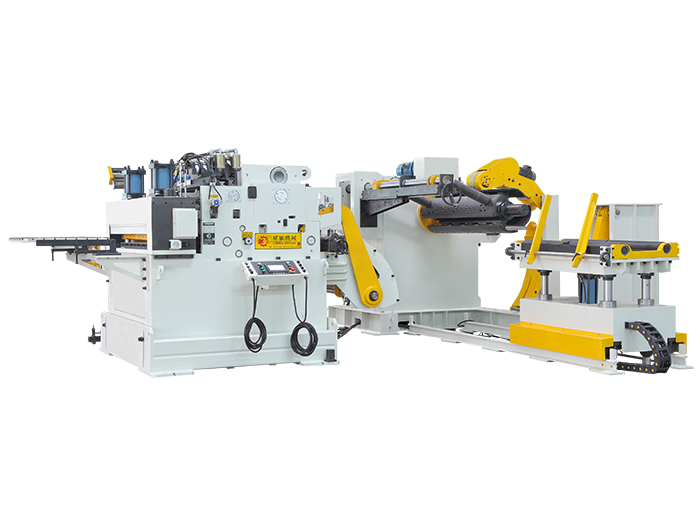4News

In today's stamping industry, as labor costs continue to increase and recruitment is difficult, raw materials continue to soar and stamping process requirements increase, resulting in higher costs in the stamping industry, which requires stamping companies to reduce labor costs, reduce waste of raw materials and Improve the product's pass rate, then how to distinguish between the three-in-one feeder and the two-in-one planer?
The three-in-one feeder and two-in-one leveling machine are the two most used automatic models in the stamping industry. The two models are very similar in shape, especially for many customers on thin and thick plates. When the customer asked for two kinds of actual inquiries, they found that the difference was very large. Therefore, many customers have doubts. Why are the two models of similar models different in price? That's because the two models are similar in appearance, but their functions, structure, and operation are very different.
1. Structural differences.
The two-in-one leveling machine can be powered or unpowered, and the press arm has no additional drive motor. The induction is usually the induction frame induction. The leveling machine is driven by a motor and a reducer. The whole machine does not have the function of lifting up and down. The three-in-one feeder racks are all powered, the press arm is equipped with a drive motor, the induction is two sets of opto-electronics can automatically control the speed, and the flattening feed head drive adopts the imported servo motor precision drive operation, the whole machine Equipped with electric lift adjustment.
2. Differences in operation and use.
The three-in-one feeder adopts the stopper arm to stop the material limit. With the pressure arm, the feeding arm and the folding arm, the fully automatic feeding and feeding process can be realized. The precision hand wheel fine adjustment mode is adopted, and the adjustment precision is high. The control operation uses a seven-inch touch screen. The two-in-one leveling machine needs manual positioning of the A-type iron for the material, introduction, feeding, material thickness adjustment, repeated adjustment, and the electronic control operation adopts the electric control box button operation mode, and the integration is not high.
3. Functional differences.
The two-in-one leveling machine is the abbreviation of the two-in-one material rack and leveling machine. It has two functions of unwinding and leveling of the material roll. It does not have the feeding function, and the feeding port needs to reserve a few meters of the waiting area. It is equipped with a feeder such as a roller feeder and an NC feeder to be used with a punching machine, which occupies a large space. The three-in-one feeder is the abbreviation of the three-in-one material leveling feeder. It has three functions of unwinding, leveling and feeding of the material roll. It can be directly matched with the punching machine, without waiting for the waiting area and occupying a small space. .
In today's stamping industry, as labor costs continue to increase and recruitment is difficult, raw materials continue to soar and stamping process requirements increase, resulting in higher costs in the stamping industry, which requires stamping companies to reduce labor costs, reduce waste of raw materials and Improve the product's pass rate, then how to distinguish between the three-in-one feeder and the two-in-one planer?
The three-in-one feeder and two-in-one leveling machine are the two most used automatic models in the stamping industry. The two models are very similar in shape, especially for many customers on thin and thick plates. When the customer asked for two kinds of actual inquiries, they found that the difference was very large. Therefore, many customers have doubts. Why are the two models of similar models different in price? That's because the two models are similar in appearance, but their functions, structure, and operation are very different.
1. Structural differences.
The two-in-one leveling machine can be powered or unpowered, and the press arm has no additional drive motor. The induction is usually the induction frame induction. The leveling machine is driven by a motor and a reducer. The whole machine does not have the function of lifting up and down. The three-in-one feeder racks are all powered, the press arm is equipped with a drive motor, the induction is two sets of opto-electronics can automatically control the speed, and the flattening feed head drive adopts the imported servo motor precision drive operation, the whole machine Equipped with electric lift adjustment.
2. Differences in operation and use.
The three-in-one feeder adopts the stopper arm to stop the material limit. With the pressure arm, the feeding arm and the folding arm, the fully automatic feeding and feeding process can be realized. The precision hand wheel fine adjustment mode is adopted, and the adjustment precision is high. The control operation uses a seven-inch touch screen. The two-in-one leveling machine needs manual positioning of the A-type iron for the material, introduction, feeding, material thickness adjustment, repeated adjustment, and the electronic control operation adopts the electric control box button operation mode, and the integration is not high.
3. Functional differences.
The two-in-one leveling machine is the abbreviation of the two-in-one material rack and leveling machine. It has two functions of unwinding and leveling of the material roll. It does not have the feeding function, and the feeding port needs to reserve a few meters of the waiting area. It is equipped with a feeder such as a roller feeder and an NC feeder to be used with a punching machine, which occupies a large space. The three-in-one feeder is the abbreviation of the three-in-one material leveling feeder. It has three functions of unwinding, leveling and feeding of the material roll. It can be directly matched with the punching machine, without waiting for the waiting area and occupying a small space.


